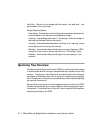
B - 2 ONline Ethernet Bridge Module Installation and Operation Guide
Root Port - The port on the bridge with the lowest “root path cost”; the
port closest to the root bridge.
Bridge Operating States:
Forwarding - Active state where the bridge is forwarding packets and an
active member of the network as a designated bridge.
Learning - Intermediate state before “forwarding” where the bridge is
learning the Address Filtering information.
Listening - Intermediate state between “blocking” and “learning” where
the bridge is just monitoring the network.
Blocking - Inactive state where the bridge is only participating in STAP
enough to know when it should move into the “forwarding” state.
Disabled - Inactive state where the bridge is not participating in the
network.
Spanning Tree Overview
The Spanning Tree Algorithm Protocol (STAP) is a method by which bridges
in a connected network configure themselves so as to prevent loops in the
network. The ports on the bridges that are determined to be redundant
are placed into Blocking state, only to be used in case the primary bridge
fails. Consequently, this protocol provides a way of automatically backing
up network connections.
By controlling which ports on which bridges are active or inactive, the STAP
transforms the network into a tree architecture, eliminating logical loops in
the network. The dotted lines in Figure B-1 show the ports that have been
selected as inactive by the STAP.


















